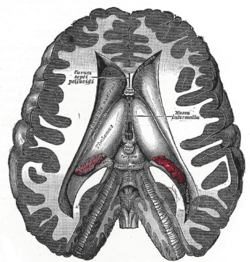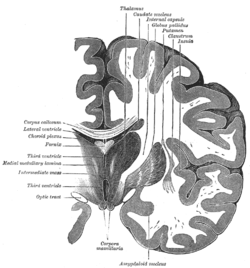Interthalamic adhesion
| Interthalamic adhesion | |
|---|---|
 Dissection showing the ventricles of the brain. (Interthalamic adhesion labeled as Massa Intermedia at center right.) | |
 Coronal section of brain through intermediate mass of third ventricle. | |
| Details | |
| Latin | Adhaesio interthalamica |
| Part of | thalamus |
| Identifiers | |
| NeuroNames | hier-284 |
| NeuroLex ID | Interthalamic adhesion |
| Dorlands /Elsevier | a_15/12112692 |
| TA | A14.1.08.103 |
| FMA | 74869 |
| Anatomical terms of neuroanatomy | |
The medial surface of the thalamus constitutes the upper part of the lateral wall of the third ventricle, and is connected to the corresponding surface of the opposite thalamus by a flattened gray band, the Interthalamic adhesion (massa intermedia, middle commissure, gray commissure).
In non-human mammals it is a large structure. In humans this mass averages about 1 cm in length in its antero-posterior diameter. It sometimes consists of two parts and occasionally is absent. The interthalamic adhesion is found in 70-80% of humans. It is present more often in females and larger than in males by an average of 53 percent.[1] When absent in development, no noticeable deficit has been observed.
It contains nerve cells and nerve fibers; a few of the latter may cross the middle line, but most of them pass toward the middle line and then curve laterally on the same side. It is still uncertain whether the interthalamic adhesion contains fibers that cross the mid-line and for this reason it is inappropriate to call it a commissure. In 1889, a Portuguese anatomist by the name of Macedo examined 215 brains, showing that male humans are approximately twice as likely to lack an interthalamic adhesion as are female humans. He anecdotally attributed the finding to a "prevailing feature of people deprived of [the interthalamic adhesion] is to present in their psychical acts a remarkable precipitation, joined to a certain dysharmony between internal and external feelings."[2] It is noted to be enlarged in patients with Chiari II malformations.[3]
Additional images
-

Thalamus
-
Human brain left dissected midsagittal view
-
Medial surface of cerebral hemisphere.Medial view.Deep dissection.
-
Medial surface of cerebral hemisphere.Medial view.Deep dissection.
-
Medial surface of cerebral hemisphere.Medial view.Deep dissection.
References
This article incorporates text in the public domain from the 20th edition of Gray's Anatomy (1918)
- ↑ http://www3.interscience.wiley.com/cgi-bin/abstract/109691976/ABSTRACT?CRETRY=1&SRETRY=0
- ↑ REGIS OLRY AND DUANE E. HAINES, "Interthalamic Adhesion: Scruples About Calling a Spade a Spade?" Journal of the History of the Neurosciences, 14:116-118, 2005
- ↑ Wolpert, S. M.; Anderson, M; Scott, R. M.; Kwan, E. S.; Runge, V. M. (1987). "Chiari II malformation: MR imaging evaluation". American Journal of Roentgenology 149 (5): 1033–42. doi:10.2214/ajr.149.5.1033. PMID 3499774.
External links
- Atlas image: n1a8p6 at the University of Michigan Health System
- Image at Harvard University
- Diagram at csuchico.edu (labeled as Massa intermedia)
- Anatomy diagram: 13048.000-3 at Roche Lexicon - illustrated navigator, Elsevier
| ||||||||||||||||||||||||||||||||||||||||||||||||||||||||||||||||||||||||||||



